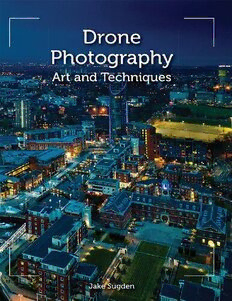
Drone photography : art and techniques PDF
Preview Drone photography : art and techniques
Drone Photography Drone Photography Art and Techniques Jake Sugden First published in 2020 by The Crowood Press Ltd Ramsbury, Marlborough Wiltshire SN8 2HR www.crowood.com [email protected] This e-book first published in 2020 © Jake Sugden 2020 All rights reserved. This e-book is copyright material and must not be copied, reproduced, transferred, distributed, leased, licensed or publicly performed or used in any way except as specifically permitted in writing by the publishers, as allowed under the terms and conditions under which it was purchased or as strictly permitted by applicable copyright law. Any unauthorised distribution or use of this text may be a direct infringement of the author’s and publisher’s rights, and those responsible may be liable in law accordingly. British Library Cataloguing-in-Publication Data A catalogue record for this book is available from the British Library. ISBN 978 1 78500 690 6 Dedication If you’re serious about photography you’ll know that you need the tireless support of those around you. This book is dedicated to Susie, my constant companion, often found ‘riding in the car’ on my many photo-adventures. Disclaimer The information in this book was accurate at the time of writing, but please check the current regulations to ensure that your flights are safe and lawful. The author and the publisher do not accept any responsibility in any manner whatsoever for any error or omission, or any loss, damage, injury, adverse outcome, or liability of any kind incurred as a result of the use of any of the information contained in this book, or reliance upon it. CONTENTS Introduction PART ONE: Getting your camera airborne 1 Early history of aerial photography 2 Types of drone and their capabilities 3 Safe and legal? 4 Flying your drone for the first time 5 Planning an aerial shoot PART TWO: Photography 6 Stills photography 7 Basic stills editing 8 Finishing your work and sharing it 9 Postscript – other forms of data capture 10 Case Study Useful resources and information Appendix: Regulations Index Introduction The very recent explosion in the availability and use of drones has been a phenomenon that has taken both photography, and the aviation world, completely by surprise. Their arrival has suddenly put highly sophisticated, very affordable, cameras on ‘easy to fly’ aircraft within the reach of budding photographers. With a new-found freedom, these photographers have enthusiastically taken to the skies in their thousands – snapping away and sharing the airways with manned aviation. And there’s the rub. With the advent of drone technology, aerial photography, which itself has been around for decades, is very much in its infancy. Unfortunately, a lot of what we read and watch about drones has negative connotations. For the most part, the media has delighted in portraying drones as the tools of voyeurs, drug gangs and activists trying to disrupt airport operations. The press has largely demonized drones as the modern-day scourge of the skies and has called for them to banned. Conversely, drones are portrayed by others as the very essence of the future in our modern-day consumerist lives. Whether you are a photographer keen to explore new territory or a beginner who wants to build your photography skills, then this book will set you on the path to safe and successful adventures. Of course, as with any technology, there are those – the majority – who embrace it for its positive potential and recognize the wide range of possibilities offered by drone technology beyond just photography, such as data collection. The potential uses for drones are almost endless and, indeed, they have already been adopted across a wide spectrum of disciplines from archaeology to zoology. Looking further ahead, developers are exploring the possibilities of unmanned flying taxis for metropolitan travel. So, whether you intend to use drones to widen your photography practice or you’re just someone who wants to use them for recreational pleasure, you will need to understand how to operate your drone safely and legally before you can go on to explore the amazing potential for photography that they offer. This book will initially guide you through the complexities, and legalities, of flying a drone. You must first ensure that you don’t fall foul of the law, or injure yourself or anyone else. Once the business of flying the drone becomes second nature then you can concentrate on developing the skills required to capture stunning aerial photographs. Remember, at the end of the day, it is the person behind the camera that gets the great shot, not the equipment. Aerial photography is no different from any other kind of photography: you are still operating and manoeuvring the camera – it’s just that now the possibilities are almost limitless and therefore potentially even more confusing. Breaking it down into manageable steps should help you navigate your way to success. With that in mind, the book is divided into two sections. Part 1 deals with the nitty-gritty of drone flying, and in Part 2 we get to grips with aerial photography. Working your way through the chapters will help you adopt a more disciplined, and planned, approach to your aerial photography; setting out with a specific shot in mind will help your photography progress rapidly from ‘middle of the road’ to meteoric. PART ONE Getting your camera airborne This section covers everything you need to know to get your camera airborne. I’ll begin by exploring the origins of aerial photography before guiding you through the choices you can make in buying your own camera drone. There follows a ‘classroom’ section, where you learn the necessary rules about flying safely and legally, before I guide you through your maiden flight. Finally, to round off the section, we’ll put all of that into practice when we look at how to go about planning an aerial photography shoot. There’s lot to take in, so first of all, let’s put it all into context.
